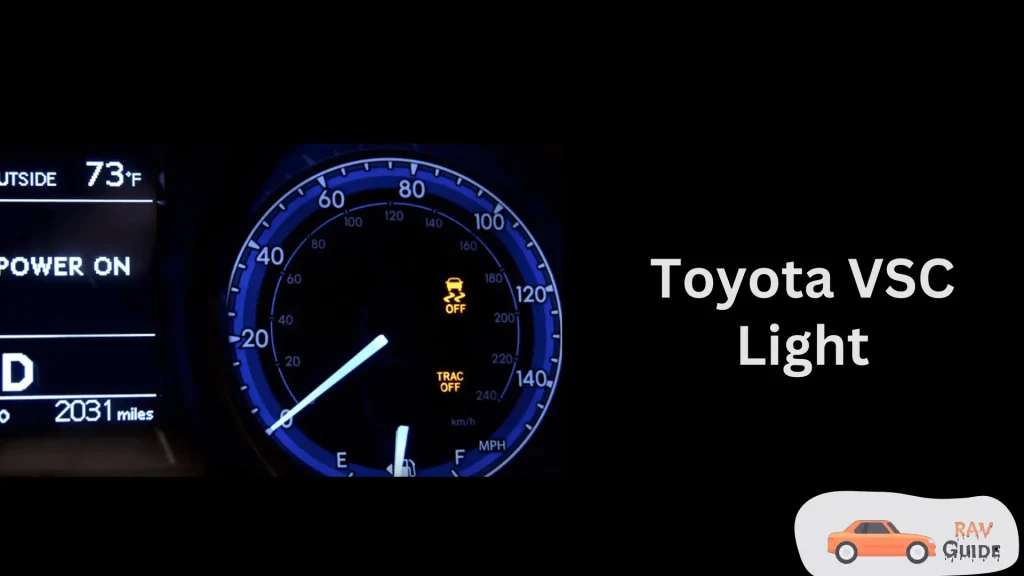Since 1995, Toyota has been equipping its vehicles with a safety feature known as Vehicle Stability Control (VSC). This system has undergone constant enhancements since its introduction, showcasing Toyota’s commitment to improving driving safety. The concept of VSC often leads to various questions among drivers.
In the following paragraphs, I aim to address some of the most common queries about Toyota VSC light. By the end of this guide, you’ll gain a comprehensive understanding of the Vehicle Stability Control system and its associated warning light.
What is VSC?
The Vehicle Stability Control (VSC) system is like a superhero for your car, helping it stay steady and avoid slipping or sliding, especially in tricky driving situations. Toyota and Lexus include this special feature in their vehicles to keep you safe on the road. Imagine VSC as a smart system that senses when your car might lose its grip and takes quick action to prevent accidents.
This fantastic technology becomes extra handy during rainy, foggy, or snowy weather. When the road conditions get tough, VSC steps in to save the day. It does this by adjusting the power to certain wheels, making sure you can steer your car back on the right path. So, it’s like a safety net that stops your car from going haywire.
Did you know that since 2012, a law in the U.S. has required all new cars to have VSC/ESC as a standard feature? That’s a cool fact! But here’s an even cooler one: the technology behind VSC has been around since the 1980s. That’s way before it became a must-have in every new car. So, next time you see the VSC light on your dashboard, make sure to pay attention. It’s your car’s way of telling you, “Hey, let’s keep things stable and safe!”
What Does the Toyota VSC Light Mean?
When your car shows the “VSC light” or says “check VSC system” on the dashboard, it’s like your car is trying to tell you something important about its traction. This light pops up when there’s a hiccup in either the VSC or ABS – kind of like a warning sign for your car’s stability.
If the VSC light blinks quickly in your Toyota or Lexus, that’s a good thing! It means the VSC system is doing its job correctly. But if the light sticks around or brings along some friends in the form of other warning lights, your car is asking for a pro’s touch.
Now, here’s a cool tidbit: the ABS and other control modules are like the VSC system’s buddies. If you spot the “VSC OFF” light on your dashboard, it’s like telling your car, “Okay, take a break!” But here’s the catch – when this light is on, the traction control won’t be there to save the day if things get slippery.
For those with newer Toyota or Lexus models, you might see a message saying “Check VSC system Light” instead of the usual VSC light. And guess what? If you accidentally press the VSC button, it’s like giving your car a little break too. The VSC system takes a timeout, but keep an eye out for the TRAC off light – it might join the party too!
How Toyota VSC Light Works?
Let’s uncover the magic behind Vehicle Stability Control (VSC) and how it plays an important role when your car decides to get a bit wobbly.
Imagine you’re steering into a curve, but without VSC, if the front wheels lose grip, your car refuses to turn. It’s like your steering wheel and the car aren’t on speaking terms anymore. Scary, right? This happens because the traction in the front tires takes a vacation.
And here’s the tricky part – when those tires finally find their grip again, they might get a bit too excited and overcompensate. Suddenly, you’re dancing dangerously close to oncoming traffic.
Now, if it’s the rear wheels doing the slip-and-slide, your car might decide to spin out of control. Even if you try to steer into the skid, it might not be enough to rescue you from the chaos.
Enter Vehicle Stability Control! It’s like having a wise friend in your car. When the wheels start acting up, VSC steps in. It’s automatic, no need for you to push any buttons. If, say, the front right wheel starts misbehaving, VSC says, “Hold up!” and slows down that wheel by reducing engine speed. It also nudges the brakes if the wheel needs an extra timeout. And here’s the cool part – the other wheels are not affected. It’s like magic, but it’s science doing its thing.
When Toyota VSC Light turn on?
Let’s dive into the reasons why that VSC light in your Toyota or Lexus might decide to turn on. It’s like your car’s way of saying, “Hey, something needs attention!” Here are a few possible causes:
1. Engine Troubles:
The VSC light often lights up when your car’s engine isn’t feeling its best. If your dashboard has a Check Engine light partying along, it’s crucial. Modern engines come with lots of fancy parts, and sometimes, one of them might act up, triggering both the check engine and VSC lights. To figure out the real issue, you’ll need to read the fault code stored in the engine control module.
2. ABS Sensor Hiccups:
Every wheel on your ride has an ABS sensor, measuring how fast it’s spinning. Now, these sensors can sometimes throw a tantrum due to moisture, rust, or dirt. If one’s acting up, the VSC light might join the scene. It’s because the VSC system relies on the data from these sensors. Also, there might be trouble with the ABS rings – those help measure speed.
3. Wiring Woes:
Imagine your car’s nervous system – that’s the wiring. If there’s a glitch in this system, it can set off the VSC light. But here’s the tricky part: spotting wiring issues isn’t a DIY task unless you’re a car wizard. If you suspect wiring problems, calling in a pro is a smart move.
4. Accidental Button Press:
Some cars have a VSC button that can accidentally be pressed, turning off the system. Before going into panic mode, double-check if you’ve unknowingly hit that button. If so, you might spot a “VSC OFF” light instead of the usual warning light. It’s like giving your car a little break, but make sure it’s intentional!
Understanding these potential causes can help you play detective and figure out why your VSC light decided to shine. If in doubt, it’s always a good idea to consult with a car expert for a thorough checkup. You should also know about resetting the tire pressure light on a Toyota RAV4.
How to Turn Toyota VSC Light On/Off?
If you ever need to switch off or on the Vehicle Stability Control (VSC) system, here’s a simple guide to follow.
Turning VSC Off:
Turning VSC On:
Remember, these steps might vary slightly depending on your Toyota model, so always refer to your vehicle’s manual for the most accurate instructions. And keep in mind, it’s usually best to leave VSC on for safer driving unless a specific situation calls for turning it off temporarily.
Benefits of Toyota VSC Light
Let’s uncover the perks of having Vehicle Stability Control (VSC) in your car. Check out these benefits that make driving a whole lot safer:
1. Smooth Turns with Braking Power:
Ever felt your car wiggling back and forth while making a turn? That’s where VSC steps in. It applies brakes strategically to keep your car stable when navigating corners. This means smoother turns, especially at higher speeds. Without VSC, your car might feel like it’s dancing, and you won’t have much say in the matter – not the best scenario for avoiding accidents.
2. Engine Speed Control to Tame Swerving:
Imagine your car suddenly swerving left and right. Scary, right? VSC comes to the rescue by adjusting the engine speed. It’s like having a guardian angel for your car, making sure it stays on the right path. This way, you can drive with more confidence, knowing that if your car starts acting up, VSC has your back.
Now, here’s a cool tidbit: while traction control is a close cousin to VSC, they’re not the same. Traction control focuses on maintaining control during acceleration and preventing slipping when traction is lost. Both work together to keep your car steady and you safe on the road.
When to Turn Off Toyota VSC Light?
Toyota usually suggests keeping the Vehicle Stability Control (VSC) on because it’s like having a safety net for your car. However, they understand that sometimes you need a bit more control, so they added a button to turn it off – but only for a specific reason.
The only legit time to hit that VSC off button is when both of your front wheels find themselves stuck in a muddy or snowy situation. It’s like giving your car a break so you can rock it back and forth to get unstuck. Here’s the trick: for this maneuver to work, both the VSC and TRAC systems need to be off.
Once you’ve successfully wiggled your way out and landed on solid ground again, it’s time to switch those systems back on. Think of it like turning off the safety belt for a moment while you do a tricky dance move, but as soon as you’re back on solid ground, safety first – belt on, or in this case, VSC on! It’s a nifty feature designed to help you out of a sticky situation without compromising your overall safety on the road.
Importance of Toyota VSC Light
It’s crucial not to ignore the Vehicle Stability Control (VSC) light unless you’ve purposefully turned off the system to get unstuck from a tricky situation. While driving with the VSC light on won’t damage your vehicle, it’s like driving without a crucial safety guard.
The VSC is your car’s superhero, designed to prevent accidents by ensuring your vehicle goes where you steer it. Without this system, you’re risking your safety and the safety of others on the road.
Here’s an interesting fact: before VSC became a standard feature in all vehicles, a study looked into its effectiveness. They checked police crashes across six states, comparing 13,987 vehicles without VSC to 5,671 with it. The results are pretty convincing – an 11.2% drop in multi-vehicle front crash involvement and a whopping 52.6% decrease in single-vehicle crashes (National Library of Medicine).
If that doesn’t scream “VSC is awesome,” I don’t know what does. So, it’s in your best interest to fix any issues with the VSC system promptly. Think of it as having a reliable sidekick ensuring you stay on the right path while driving – a small effort for a big boost in safety!
Conclusion
In conclusion, Toyota’s VSC light is more than just a dashboard signal – it’s your car’s safety guardian. Turning it off is only advised in specific situations, like getting unstuck from mud or snow. Ignoring the VSC light for too long can jeopardize its essential role in preventing accidents. So, keep it on, fix any issues promptly, and let this smart system be your silent protector on the road.

